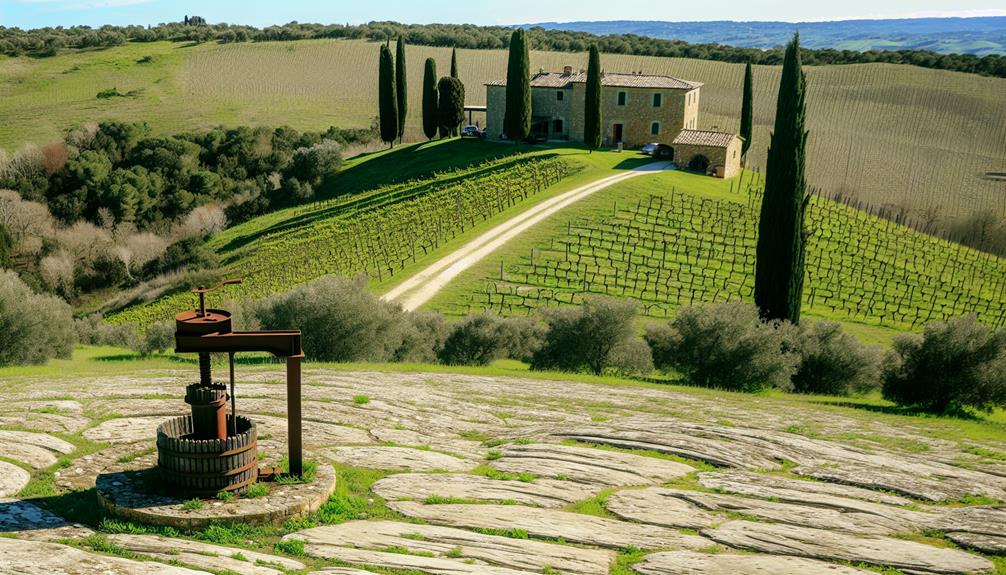Wine Trails of Umbria: Touring the Region’s Best Vineyards(stunning villas for rent in Umbria)Wine Trails of Umbria: Touring the Region’s Best Vineyards(stunning villas for rent in Umbria)
Umbria is a paradise for wine enthusiasts, with rolling hills and vineyards producing some of Italy’s most exquisite wines. From the famous Sagrantino of Montefalco to the crisp whites of Orvieto, the region offers a wine-tasting journey like no other. Our guide explores the top vineyards and wine trails to help you savor the best of Umbrian wines. For an unforgettable stay amidst this beautiful landscape, explore our stunning villas for rent in Umbria and make your wine tour even more special. Cheers to the flavors of Umbria!
As you plan your Italian getaway, consider exploring the picturesque wine trails of Umbria. This charming region is home to 13 DOC and 6 DOCG wines, each offering a unique taste of the local heritage. You’ll discover notable areas like Colli Perugini and Colli Martani, where Sagrantino and Sangiovese grapes thrive. But what sets Umbria’s wine trails apart from others? The answer lies in its carefully crafted blend of medieval charm and modern winemaking techniques. To uncover the secrets behind this perfect blend, you’ll need to look closer at the region’s top vineyards – and that’s exactly where we’ll begin.

Exploring Umbria’s Wine Routes
As you explore Umbria’s wine scene, you’ll find yourself winding through scenic routes that showcase the region’s diverse wine production. The region is home to 13 DOC and 6 DOCG wines, each with its unique characteristics.
Umbria’s wine routes are divided into several areas, including the Colli Perugini, Colli Martani, and the Lake Trasimeno area. The Colli Perugini area is known for its Grechetto and Trebbiano-based wines, while the Colli Martani area produces wines from the Sangiovese and Merlot grapes.
As you drive through the rolling hills and picturesque villages, you’ll notice the different soil types and microclimates that contribute to the region’s diverse wine styles. The roads are generally well-marked and easy to navigate, making it simple to plan a self-guided wine tour.
To get the most out of your wine route experience, consider visiting during the spring and autumn seasons when the weather is mild and the scenery is particularly beautiful.
Additionally, many local wineries offer wine tastings and tours, providing a unique opportunity to learn about Umbria’s wine production techniques and traditions.
Top Vineyards to Visit
Your wine route exploration in Umbria wouldn’t be complete without visiting some of the region’s top vineyards. These wineries offer an immersive experience, allowing you to explore the art of winemaking and sample some of the best wines Umbria has to offer.
Castello di Magliano is a must-visit, with its stunning medieval architecture and beautifully manicured vineyards. As you explore the castle’s cellars, you’ll discover the traditional winemaking techniques used to produce their high-quality wines.
Meanwhile, Falesco’s modern winery is a showcase of the region’s innovative approach to winemaking, with its state-of-the-art facilities and cutting-edge technology.
At Castello di Poggio Argentiera, you’ll have the opportunity to explore the vineyards and learn about the winemaking process firsthand. The winery’s focus on sustainability and organic farming practices is evident in the quality of their wines.
Finally, visit the scenic vineyards of Castello di Spello, where you can enjoy breathtaking views of the Umbrian countryside while sampling some of their exceptional wines.
Each of these top vineyards offers a unique experience, providing an in-depth look at Umbria’s rich winemaking heritage.
Local Wine Varietals
With Umbria’s diverse terroir and favorable climate, the region is home to a variety of exceptional local wine varietals.
You’ll find several indigenous grape varieties, including Sagrantino, which is Umbria’s flagship red wine grape. This varietal produces full-bodied wines with robust tannins, dark fruit flavors, and hints of spice.
Another notable red varietal is Sangiovese, which produces wines with bright acidity, moderate tannins, and flavors of cherry and plum.
For white wines, Umbria is known for its Grechetto and Trebbiano varieties. Grechetto produces wines with crisp acidity, moderate body, and flavors of green apple, citrus, and floral notes.
Trebbiano, on the other hand, produces wines with high acidity, medium body, and flavors of stone fruit, citrus, and herbal notes.
You may also come across wines made from the international varietals Merlot, Cabernet Sauvignon, and Chardonnay, which are often blended with indigenous varieties to create unique and complex wines.
As you explore Umbria’s wine trails, you’ll have the opportunity to taste these local wine varietals and experience the region’s rich winemaking traditions firsthand.